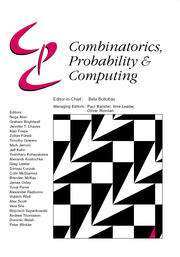No CrossRef data available.
Article contents
Bipartite-ness under smooth conditions
Published online by Cambridge University Press: 03 February 2023
Abstract
Given a family  $\mathcal{F}$ of bipartite graphs, the Zarankiewicz number
$\mathcal{F}$ of bipartite graphs, the Zarankiewicz number  $z(m,n,\mathcal{F})$ is the maximum number of edges in an
$z(m,n,\mathcal{F})$ is the maximum number of edges in an  $m$ by
$m$ by  $n$ bipartite graph
$n$ bipartite graph  $G$ that does not contain any member of
$G$ that does not contain any member of  $\mathcal{F}$ as a subgraph (such
$\mathcal{F}$ as a subgraph (such  $G$ is called
$G$ is called  $\mathcal{F}$-free). For
$\mathcal{F}$-free). For  $1\leq \beta \lt \alpha \lt 2$, a family
$1\leq \beta \lt \alpha \lt 2$, a family  $\mathcal{F}$ of bipartite graphs is
$\mathcal{F}$ of bipartite graphs is  $(\alpha,\beta )$-smooth if for some
$(\alpha,\beta )$-smooth if for some  $\rho \gt 0$ and every
$\rho \gt 0$ and every  $m\leq n$,
$m\leq n$,  $z(m,n,\mathcal{F})=\rho m n^{\alpha -1}+O(n^\beta )$. Motivated by their work on a conjecture of Erdős and Simonovits on compactness and a classic result of Andrásfai, Erdős and Sós, Allen, Keevash, Sudakov and Verstraëte proved that for any
$z(m,n,\mathcal{F})=\rho m n^{\alpha -1}+O(n^\beta )$. Motivated by their work on a conjecture of Erdős and Simonovits on compactness and a classic result of Andrásfai, Erdős and Sós, Allen, Keevash, Sudakov and Verstraëte proved that for any  $(\alpha,\beta )$-smooth family
$(\alpha,\beta )$-smooth family  $\mathcal{F}$, there exists
$\mathcal{F}$, there exists  $k_0$ such that for all odd
$k_0$ such that for all odd  $k\geq k_0$ and sufficiently large
$k\geq k_0$ and sufficiently large  $n$, any
$n$, any  $n$-vertex
$n$-vertex  $\mathcal{F}\cup \{C_k\}$-free graph with minimum degree at least
$\mathcal{F}\cup \{C_k\}$-free graph with minimum degree at least  $\rho (\frac{2n}{5}+o(n))^{\alpha -1}$ is bipartite. In this paper, we strengthen their result by showing that for every real
$\rho (\frac{2n}{5}+o(n))^{\alpha -1}$ is bipartite. In this paper, we strengthen their result by showing that for every real  $\delta \gt 0$, there exists
$\delta \gt 0$, there exists  $k_0$ such that for all odd
$k_0$ such that for all odd  $k\geq k_0$ and sufficiently large
$k\geq k_0$ and sufficiently large  $n$, any
$n$, any  $n$-vertex
$n$-vertex  $\mathcal{F}\cup \{C_k\}$-free graph with minimum degree at least
$\mathcal{F}\cup \{C_k\}$-free graph with minimum degree at least  $\delta n^{\alpha -1}$ is bipartite. Furthermore, our result holds under a more relaxed notion of smoothness, which include the families
$\delta n^{\alpha -1}$ is bipartite. Furthermore, our result holds under a more relaxed notion of smoothness, which include the families  $\mathcal{F}$ consisting of the single graph
$\mathcal{F}$ consisting of the single graph  $K_{s,t}$ when
$K_{s,t}$ when  $t\gg s$. We also prove an analogous result for
$t\gg s$. We also prove an analogous result for  $C_{2\ell }$-free graphs for every
$C_{2\ell }$-free graphs for every  $\ell \geq 2$, which complements a result of Keevash, Sudakov and Verstraëte.
$\ell \geq 2$, which complements a result of Keevash, Sudakov and Verstraëte.
Keywords
MSC classification
Information
- Type
- Paper
- Information
- Copyright
- © The Author(s), 2023. Published by Cambridge University Press

